Tag Archive: augmented input
March 8, 2018
by Carole Zangari -
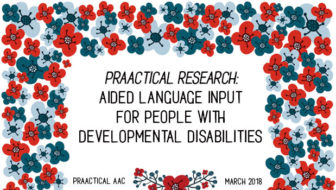
We’re pleased to welcome back Dr. Kathy Howery for another analysis of an AAC research article. Kathy is based in Alberta, Canada, and has worked in the field of AT and special education for over three decades. In the past year, she completed her doctoral studies where she used phenomenological methods to seek to understand the lived experience of speaking with/through a speech generating device. Kathy is currently working as a consultant to schools and school districts across Alberta focusing primarily on children and youth with complex communication needs. ::::::::::::::::::::::::::::::::::::::::::::::::::::::; Allen, A. A., Schlosser, R. W., Brock, K. L., & Shane, H. C. (2017). The effectiveness of aided augmented input techniques for persons with developmental disabilities: A systematic review. Augmentative and Alternative Communication, 33, 149-159. What this Article is All About (The Focus of the Research) This article presents the results of a systematic review of the research into what the authors refer... [Read More...]
Filed under: Featured Posts, PrAACtical Thinking
Tagged With: aided language input, augmented input, Kathy Howery, research
April 14, 2016
by Carole Zangari -
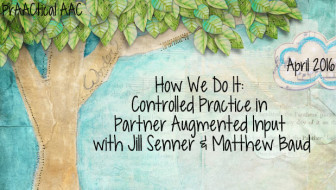
Today, we welcome back Dr. Jill Senner and Matthew Baud to talk about some of their strategies for implementing AAC. They have some great ideas for helping partners better support AAC learners. You can read some of their previous posts here. In the meantime, let’s see how they are helping communication partners develop their AAC facilitation skills. :::::::::::::::::::::::::::::::::::::::::::::::::::::::::::: Most of us already know that evidence-based research supports the use of partner-augmented input (PAI) as an intervention strategy for individuals who use AAC. However, simply having awareness of a strategy does not mean that one can easily use it. To quote Jim Knight, “We wouldn’t teach someone to drive by giving them a lecture, tossing them a book, and then turning them loose on the freeway.” Indeed, in order to learn a new skill, communication partners often need practice. In fact, one may need to try a new strategy or skill... [Read More...]
Filed under: Featured Posts, PrAACtical Thinking
Tagged With: augmented input, classroom, partner training, schools
August 3, 2014
by Carole Zangari -
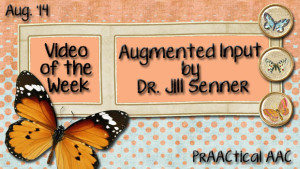
Work with learners who have difficulty processing language and are just learning to use their AAC systems? Dr. Jill Senner has a strategy for you! Thanks to DynaVox for hosting this terrific presentation. Direct link to video: http://www.dynavoxtech.com/training/toolkit/details.aspx?id=261
Filed under: Video of the Week
Tagged With: aided language input, augmented input, Jill Senner
June 29, 2013
by Carole Zangari -
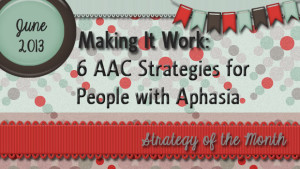
People with aphasia are often most successful when a number of different strategies are combined. In this post, we discuss a number of strategies that we can use in our therapy and teach to communication partners. Augmented Input We’ve written so many posts about aided language input that we’re almost embarrassed to bring it up again. Almost. It seems like no matter which age group or clinical population is the subject of our post, that strategy plays a central role. It is the same for people with aphasia with one exception. They benefit from a broader array of input cues, such as gestures, writing, and even pantomime. Augmented input is the term that is used to refer to oral language that is supplemented with pictures, print, gestures, pantomime, and the use of objects in the environment. By using these things as you speak, you enhance the ability of the person... [Read More...]
Filed under: Strategy of the Month
Tagged With: aided language input, aphasia, augmented input, communication book, rating scale, supplementation, tagged questions, written choice strategy
June 3, 2013
by Robin Parker -
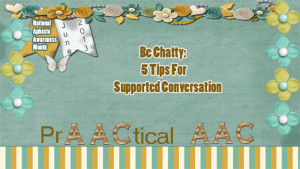
There are many strategies to support communication and conversation for individuals with significant aphasia. Conversation is about connecting with people. We engage in conversation about interesting and relevant experiences to help with connecting. To best connect and be part of conversation, there needs to be comprehension and expression from each communication partner. With aphasia, there is difficulty in these language areas, but it is not that language is lost, it is that it needs to be accessed differently. These quick start tips will support accessing conversation and connections. Write or Draw Key Words– When you are talking, write key words to support your spoken language. Gesture Key Words– When you are talking, supplement spoken language with gestures to illustrate a main point Show Related Photographs or Remnants– While you are talking, use photographs or some remnant of the an experience or event you are talking about. Written Choices to... [Read More...]
Filed under: PrAACtical Thinking
Tagged With: aphasia, augmented comprehension, augmented input, Supported Communication




